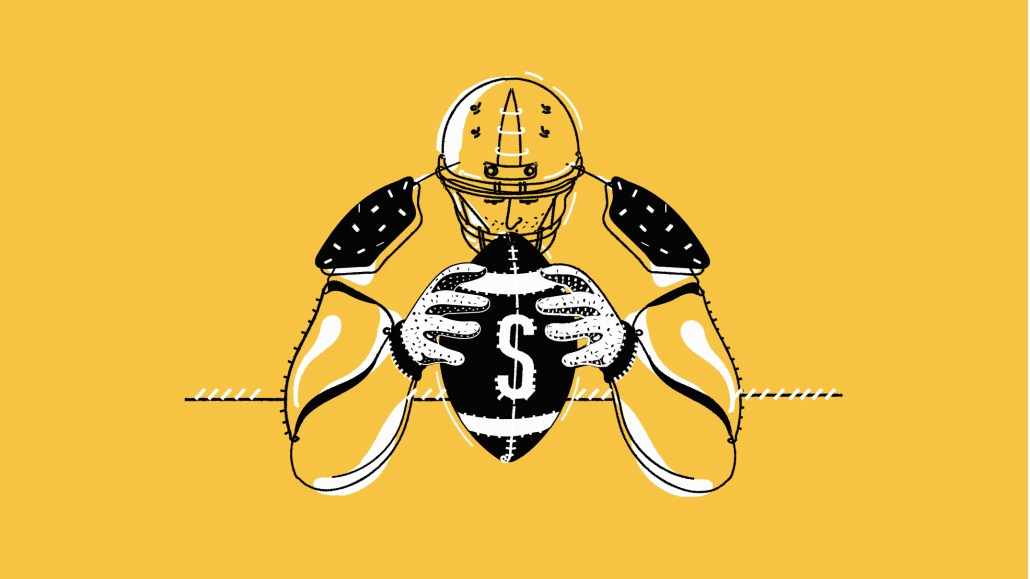Connect with execs from The New York Times, TIME, Dotdash Meredith and many more
What a $5.5 million Super Bowl ad can buy in digital media

The saying goes there’s no business like show business. And even in the midst of a global pandemic, the Big Game must go on.
However, Super Bowl superstar marketers like Budweiser, Coca-Cola and Pepsi are sitting this year out. Perhaps rightly so, because this year’s ad spots come with a shiny price tag — going for an estimated $5.5 million for a 30-second spot.
It’s no secret that advertising during the Big Game is expensive. But for what it’s worth, here’s a look at what $5.5 million can afford a buyer in the digital arena. (Find our previous tallies here, here, and here.)
3.7 million paid clicks on Drizly display ads
Football and beer: A match made in heaven. And in the midst of a global pandemic, more and more consumers are using delivery services like Drizly to have food and drinks brought straight to their door. Advertisers could find an audience on the service app.
According to a media buyer, for Drizly search or display ads, the cost-per-click varies by product category, ranging from $1.45 to $2.60. In this case, a budget of $5.5 million could pick up between 2.1 and 3.7 million paid clicks.
6.8 million clicks on Walgreens search ads
The average cost-per-click for a Walgreens’ search ad runs buyers an estimated $.80, according to a media buyer. With that number in mind, the $5.5 million a buyer would have spent on a Super Bowl spot could garner 6.8 million clicks at Walgreens.
2.8 million clicks on CVS search ads
CVS expanded its offerings into the retail media business mid-last year with the launch of its CVS Media Exchange, as Digiday previously reported. Media buyers looking to spend here should expect to shell out a least $1.90 per click, according to a media buyer. Crunching the numbers, a budget of $5.5 million could mean 2.8 million clicks with CVS.
427 million impressions on Discovery+
Millions of people will be tuned into the big game to watch the Kansas City Chiefs face off against the Tampa Bay Buccaneers. But for non-sports fans, streaming services like Discovery+ may be a viable option. Per previous Digiday reporting, Discovery unveiled its DTC streaming service earlier this year with two subscription tiers: ad-supported and ad-free. According to a media buyer, campaigns on Discovery+ could run a buyer $12.87 cost-per-million With a budget of $5.5 million, buyers could afford 427 million impressions on the streaming platform.
275 million impressions on YouTube
According to research from Oracle CX, Gen-Z is optimistic about this year, with 41% of fans betting on better ads this year. And they may be looking to YouTube to find replays after spots air, making YouTube the place advertisers may want to be on game day. According to a media buyer, YouTube skippable in-stream ads run an estimated $.02. In terms of Big Game spending, that could make for 275 million impressions on the video platform.
6.1 million paid clicks on Google search
Expect to see a lot of searches during this year’s Big Game. Ahead of this year’s Super Bowl, consumers have already taken to Google, researching teams, halftime performer The Weeknd and showtimes, according to Google Trends. Per a media buyer, a search ad on Google could cost media buyers between $.90 and $1 on average. With $5.5 million, buyers could get between 5.5 million and 6.1 million clicks in Google search ads.
22 weeks of TikTok #hashtag challenges with a top tier influencer
Working with TikTok influencers comes in tiers, depending on the influencer’s ranking, according to a media buyer. A TikToker like Charli D’Amelio, who has more than 100 million followers, could come with an estimated $100,000 price tag. On the short form video app, advertisers could opt for a hashtag challenge at $150,000 per week. Running those together with a $5.5 million budget, buyers could afford 22 weeks of hashtag challenges working with a top tier influencer.
More in Marketing

In Graphic Detail: Inside the state of the creator economy industrial complex
The creator economy might have started out as an alternative to traditional media, but is becoming more and more like it as it professionalizes.

Shopify has quietly set boundaries for ‘buy-for-me’ AI bots on merchant sites
The change comes at a time when major retailers like Amazon and Walmart are leaning into agentic AI.

WTF is ‘Google Zero’?
The era of “Google Zero” — industry shorthand for a world where Google keeps users inside its own walls — is here.








